When it comes to supporting healthy hydration habits and nutritional milestones in early childhood, few tools are as significant—or as hotly debated—as the sippy cup. In today’s marketplace, the silicone sippy has emerged as a favored choice among parents and pediatricians alike, offering a safe, adaptable, and developmentally supportive way to transition children from bottles to open cups. Its popularity is not just a passing trend but a reflection of growing awareness about material safety, ergonomic design, and the need to balance convenience with long-term health outcomes. In this comprehensive guide, we’ll explore everything caregivers need to know about choosing the right silicone sippy cup for their growing child—from materials and mechanics to design and durability—while maintaining a close eye on nutritional development and hydration best practices.
You may also like: The Ultimate Guide to Choosing the Best Sippy Cup for Healthy Hydration and Growing Kids
Why the Right Drinking Tool Matters in Early Childhood Nutrition
Establishing healthy beverage habits in the first few years of life is critical not only for hydration but also for setting the stage for lifelong nutrition. A well-chosen training cup can support proper oral motor development, reduce the risk of dental caries, and encourage water consumption over sugary alternatives. It can also empower toddlers to develop independence and confidence during meals, promoting self-regulation and participation in daily routines. When parents transition too quickly from bottle to open cup—or rely on poorly designed options—they may unintentionally create hurdles in speech development, jaw alignment, or even digestion, especially when posture and sucking patterns are disrupted. This makes the role of a thoughtfully selected silicone sippy cup all the more pivotal.
Silicone sippy cups, in particular, offer a gentle yet durable material that is soft on sensitive gums, flexible for growing hands, and free from toxins often found in older plastic models. More importantly, they can serve as a stepping stone between the bottle and more advanced drinking vessels, giving children a smoother and safer learning curve. The goal isn’t just to hydrate but to nurture developmental growth with every sip.

Understanding the Benefits of Silicone in Sippy Cups
One of the reasons silicone sippy cups have gained traction in recent years is due to growing parental concern over chemical exposure from plastic containers. Unlike traditional plastic cups, silicone is a non-toxic, BPA-free, and phthalate-free material that resists leaching even under high temperatures or when cleaned frequently in dishwashers. Medical-grade or food-grade silicone is heat-resistant, stain-resistant, and inherently hypoallergenic, making it an ideal choice for products that will be regularly handled by infants and toddlers.
Silicone also offers flexibility and durability, which can absorb impact from drops without breaking or chipping—something that becomes incredibly important when toddlers are constantly testing the limits of gravity. Unlike rigid cups that may crack or sharp plastic edges that could injure sensitive mouths, silicone sippy options tend to offer smoother transitions and fewer risks. Moreover, because many silicone sippy designs incorporate soft spouts or straw attachments, they’re suitable for younger children who are still developing oral strength and coordination.
Another advantage lies in the texture and grip. Silicone provides a soft, tactile surface that’s easy for little hands to hold, enhancing a child’s ability to manipulate their cup independently. This seemingly simple feature plays a major role in a child’s development of fine motor skills and self-feeding confidence. Over time, these seemingly small wins compound into bigger developmental leaps.
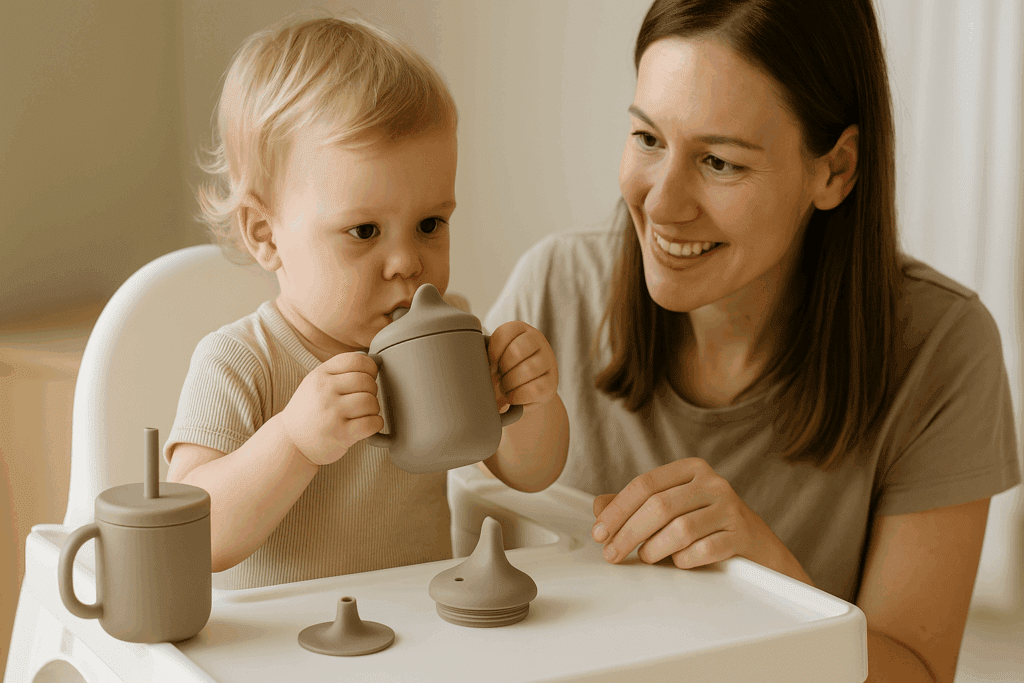
How Silicone Sippy Cups Support Training Cup Transitions
For children around 6 to 12 months of age, pediatricians typically recommend starting the transition from bottles to cups. During this sensitive window, the right training cup can significantly influence how successful—and how healthy—that transition becomes. A training cup bridges the developmental gap between passive sucking from a bottle and active sipping or gulping from an open cup. The silicone sippy cup excels in this role due to its adaptive features and child-friendly construction.
Unlike traditional hard-spout sippy cups, which can sometimes mimic bottles too closely and extend dependency, silicone sippy cups often include a soft spout or straw that encourages a more mature drinking motion. Some models feature valves that only release liquid when suction is applied, helping toddlers learn to control liquid flow without spilling excessively. This encourages both hydration and autonomy while teaching important oral skills needed for speech development and feeding.
Another way silicone sippy cups aid the training process is through their modular design. Many modern silicone cups come with interchangeable lids, allowing parents to start with a spouted lid and eventually move to a straw or open top as the child progresses. This flexibility not only saves money but ensures that the child has consistent familiarity with the cup’s shape and feel, making transitions smoother and less stressful for everyone involved.
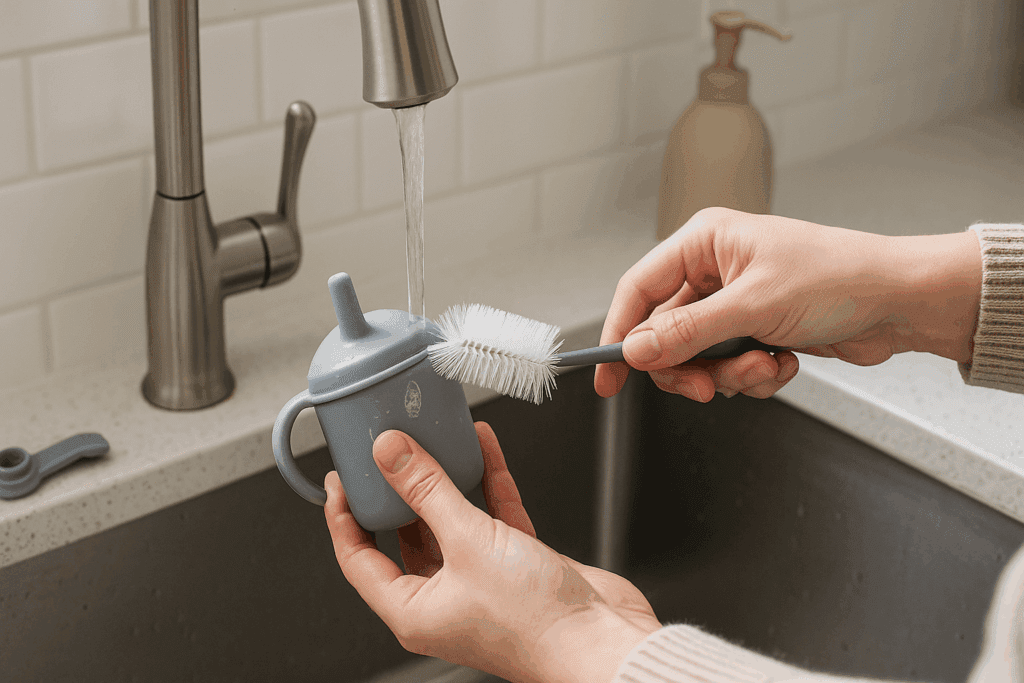
Critical Safety Considerations When Choosing a Silicone Sippy
While silicone sippy cups are generally considered safe, not all products are created equal. Parents must remain vigilant about quality standards, manufacturing practices, and design choices that affect the safety and hygiene of the product. The first priority is always to ensure that the product is made from 100% food-grade silicone, ideally certified by reputable safety organizations such as the FDA, LFGB, or CPSIA. These certifications confirm that the silicone used is free from toxins, heavy metals, and other harmful chemicals that can leach into beverages over time.
Next, attention should be paid to the design of the cup, including the spout or straw attachment. Some poorly designed spouts may detach easily, presenting a choking hazard. Others may harbor bacteria in hidden crevices or be difficult to clean thoroughly, even with repeated dishwasher cycles. Look for one-piece or minimally jointed designs that are dishwasher-safe and easy to sterilize. Transparency is also key—trustworthy brands are upfront about their materials and cleaning instructions.
Ventilation systems also deserve scrutiny. Properly ventilated silicone sippy cups help regulate air intake, reducing the risk of colic or gas buildup from swallowing too much air during drinking. These may come in the form of air valves or specially engineered straws that help control suction. Though often overlooked, this feature plays a big role in a child’s digestive comfort and overall hydration experience.
Essential Design Features to Look For in a Silicone Sippy
Design plays a fundamental role not only in safety but also in functionality and developmental compatibility. One of the first design elements to assess is the spout type. Soft spouts made from silicone are ideal for younger babies as they offer gentleness and flexibility, reducing pressure on the gums and allowing a natural sipping action. For older toddlers, straw cups or 360-degree drinking lids encourage more advanced coordination and mimic adult drinking behavior.
Handles are another crucial design feature. Removable or integrated handles can significantly enhance a child’s control over the cup, especially when their motor skills are still developing. Some silicone sippy designs feature ergonomic or anti-slip grips, which provide added stability during self-feeding. While not every child needs handles, offering the option can make the transition easier and more confidence-boosting.
Leak resistance is a priority for many parents, especially when traveling or managing multiple children. Some silicone sippy cups feature anti-leak valves, twist-lock lids, or compression seals to prevent messes. However, overly complex leak-proof mechanisms may hinder ease of cleaning, so it’s essential to strike a balance. The best designs prioritize simplicity, allowing for effective sealing without intricate parts that might trap mold or bacteria.

Silicone Sippy vs. Other Training Cup Materials: What Science Says
When comparing a silicone sippy cup to alternatives made of plastic, stainless steel, or glass, several scientific and practical distinctions emerge. Plastics, while historically the most popular due to low cost and availability, have come under scrutiny for containing BPA, BPS, and phthalates—chemicals that may act as endocrine disruptors with potential long-term effects on child development. Even BPA-free plastics are not necessarily inert, with newer studies suggesting that replacement chemicals might carry similar risks.
Stainless steel offers durability and temperature insulation, making it great for older children or outdoor use. However, steel cups are heavier and may be intimidating for toddlers still learning coordination. They’re also more likely to dent or damage floors when dropped. Glass is inert and chemical-free, but obviously poses a breakage hazard, making it unsuitable for most children under three years of age.
In contrast, a silicone sippy cup strikes a balance between safety, softness, and versatility. Silicone is inert, durable, and easy to clean, making it ideal for everyday use. Its resistance to high temperatures also makes it safer for sterilization—a critical feature for families with young infants. From a developmental perspective, the flexibility of silicone supports a gentler learning curve and is more forgiving of spills and drops.
Top Silicone Sippy Cup Features That Support Healthy Hydration
Hydration in early childhood is often overlooked, yet it plays a critical role in everything from mood and energy to digestion and temperature regulation. A thoughtfully designed silicone sippy cup can encourage consistent water intake by being easy, fun, and intuitive to use. Visual appeal, color choice, and tactile features can engage children who might otherwise resist drinking plain water, making the cup itself an ally in promoting hydration.
Some silicone sippy designs incorporate measurement markers, allowing caregivers to track fluid intake throughout the day—an especially helpful feature for children recovering from illness or those with feeding challenges. Others may include temperature-sensitive materials or insulating sleeves to keep water at an appealing temperature, encouraging more frequent sips during play or outdoor activity.
One often-overlooked feature is the cup’s base stability. Silicone bases are often weighted or grip-enhanced, reducing the likelihood of tipping and spills. This may sound like a small perk, but it plays a large role in creating a calm and focused mealtime environment. Less stress around messes can lead to more relaxed, successful drinking experiences.
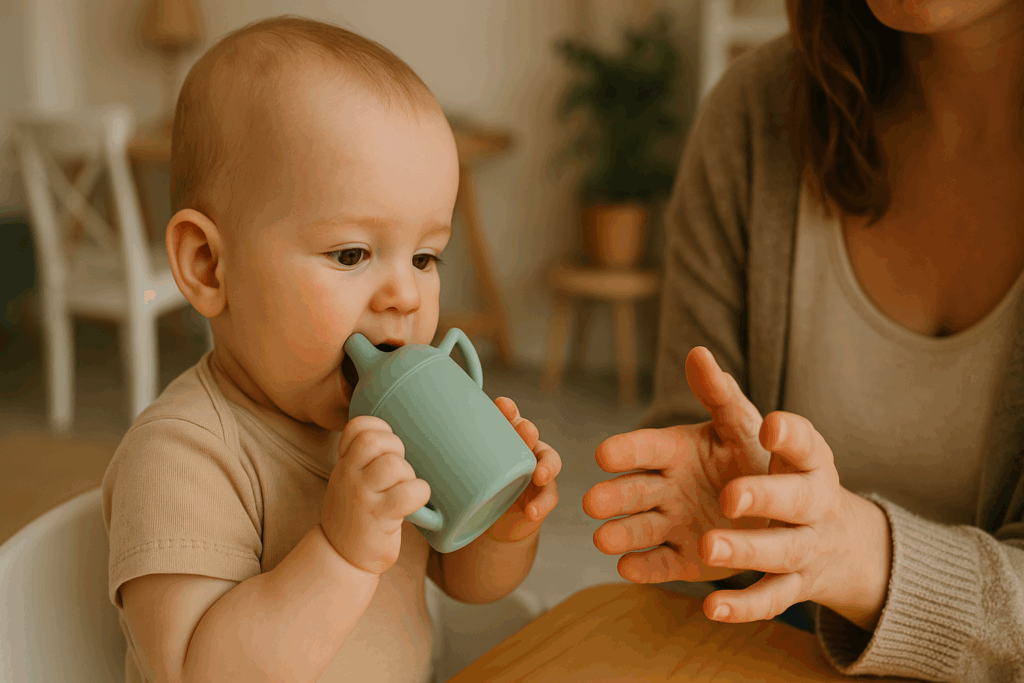
How to Introduce a Silicone Sippy to Your Child
Introducing a silicone sippy cup for the first time can be a turning point in a child’s feeding journey. The key to success lies in patience, consistency, and modeling. Children learn by observation, so caregivers should demonstrate sipping from the cup themselves to build familiarity. Initially, it’s wise to introduce the cup when the child is calm and not overly hungry or thirsty, so that frustration is minimized.
Filling the cup with a small amount of breast milk, formula, or familiar fluids can make the transition easier. Some children may reject the cup at first, especially if they are attached to bottle feeding, but gentle repetition—offering the cup at every meal—can build positive associations over time. Allowing the child to play with the cup, explore its texture, and even chew on it helps build comfort and curiosity.
Parents should also avoid using the silicone sippy as a pacifier or allowing the child to carry it throughout the day, as this can lead to tooth decay or poor hydration habits. Designate specific times and places for cup use—ideally during meals or snack times—so the child begins to associate it with nourishment and self-regulation rather than comfort alone.
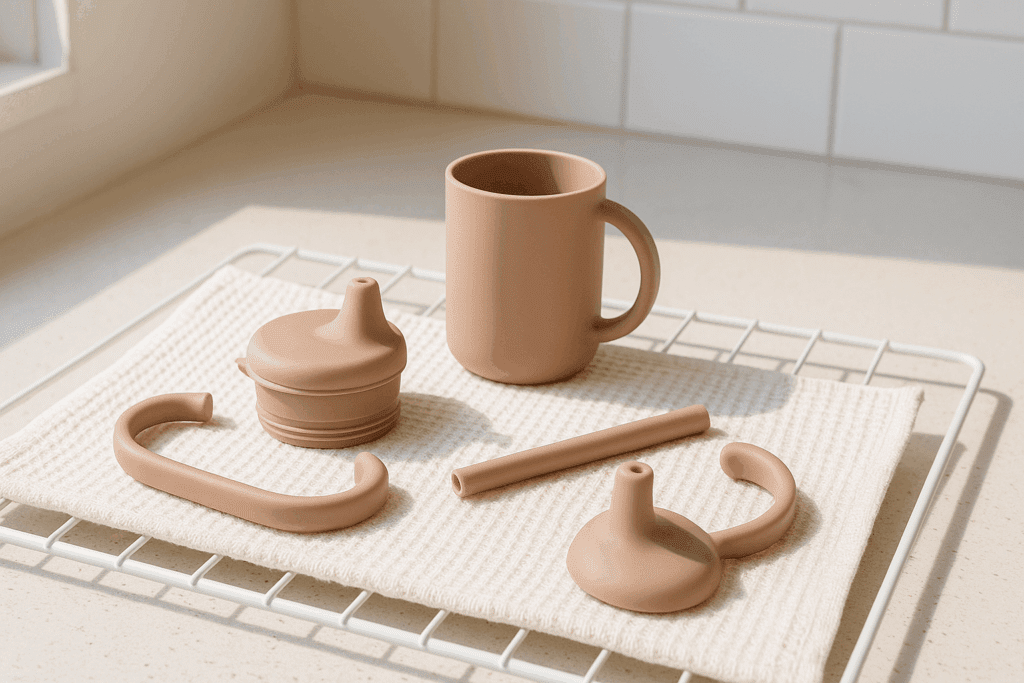
Cleaning and Maintenance Tips for Long-Lasting Silicone Sippy Cups
Proper hygiene is essential to ensure the long-term safety and performance of a silicone sippy cup. While many designs are labeled dishwasher-safe, handwashing with a bottle brush and mild soap often allows for a more thorough inspection and cleaning. Paying special attention to spouts, valves, and straw mechanisms ensures that no milk or juice residue remains trapped in hidden nooks.
To avoid mold or bacterial buildup, disassemble all removable parts after each use and allow them to air-dry completely before reassembly. Once a week, deep-cleaning in boiling water or a steam sterilizer can help eliminate lingering pathogens. If the cup develops a lingering odor or sticky residue, a vinegar soak or baking soda rinse may restore freshness without introducing harsh chemicals.
Visual inspection should also be part of regular maintenance. Look for any signs of discoloration, cracking, or material fatigue, particularly in the spout and straw areas. Silicone is generally long-lasting, but over time and with frequent exposure to heat or acidic beverages, even the most durable materials can degrade. When in doubt, replace any questionable components to maintain optimal safety.
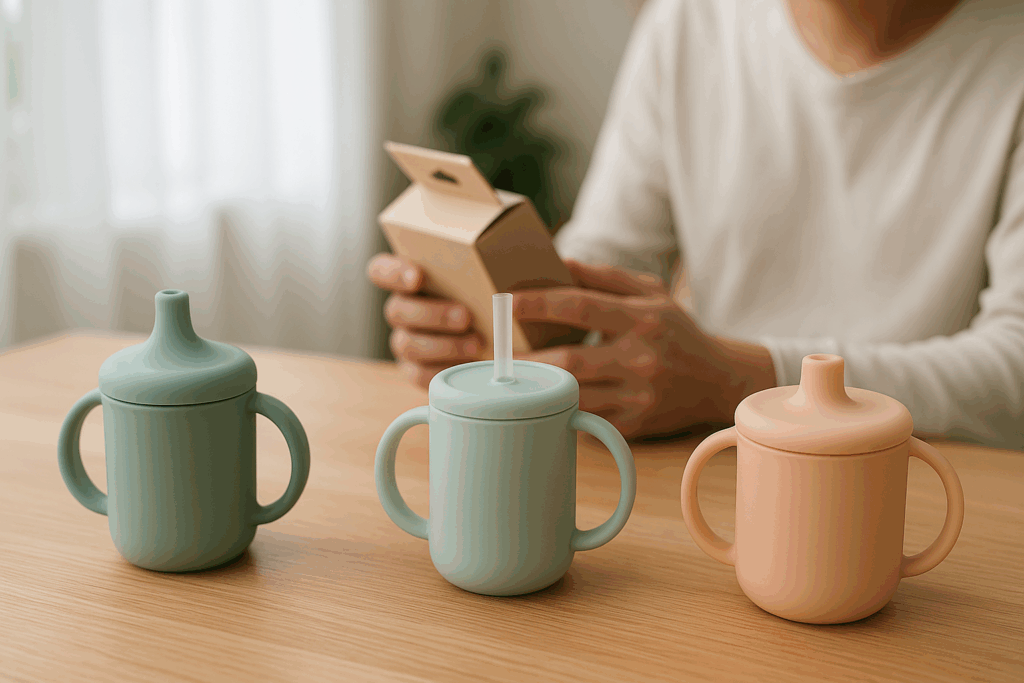
Navigating the Silicone Sippy Market: What to Look For in a Brand
As the popularity of silicone sippy cups continues to rise, so too does the number of brands offering them. Not all brands adhere to the same manufacturing standards, and discerning parents must consider a few critical factors when selecting the right cup for their child. First, transparency about materials and testing is essential. Look for brands that explicitly state their silicone is 100% food-grade, free from BPA, PVC, and lead, and that their products are tested by third-party laboratories for compliance with global safety standards.
Second, examine the brand’s customer support and return policy. Reputable companies stand behind their products with satisfaction guarantees, hassle-free returns, and responsive customer service. This speaks volumes about the confidence they place in their design and durability.
Finally, look at parent reviews and pediatric recommendations. While anecdotal evidence should not replace clinical data, consistent praise—or criticism—across multiple sources can help guide decision-making. Trusted parenting blogs, pediatric clinics, and product safety forums can offer additional insight into which silicone sippy options deliver on both safety and functionality.
Frequently Asked Questions About Choosing and Using a Silicone Sippy Cup for Growing Kids
Why are silicone sippy cups increasingly recommended by pediatric occupational therapists?
Silicone sippy cups are often favored by pediatric occupational therapists because of their soft, pliable design, which supports the oral-motor development needed for mature swallowing patterns and proper speech articulation. The flexibility of silicone helps reduce the risk of oral aversion in sensory-sensitive children by offering a gentler tactile experience. Therapists also point out that these cups tend to encourage more active muscle engagement in the lips and tongue, fostering stronger neuromuscular coordination. Unlike rigid plastic cups that may encourage passive sucking, a silicone sippy requires more precise movements that mirror the drinking mechanics of open cups. This makes them an excellent tool for developmental therapy and early intervention when delays or feeding challenges are present.
Can a silicone sippy cup be used with breast milk or formula, and are there precautions to consider?
Yes, a silicone sippy cup can be used with both breast milk and formula, particularly during the transitional phase from bottle to cup. However, because breast milk is highly sensitive to heat and prone to spoilage, it’s important to avoid prolonged exposure to room temperature or direct sunlight, especially in non-insulated silicone designs. Using a training cup with measurement markings can be helpful in tracking intake during feedings. Additionally, parents should ensure the cup is fully sterilized before each use, as milk proteins can cling to silicone surfaces and create bacterial growth if not cleaned properly. Some parents opt to use a dedicated silicone sippy exclusively for milk and another for water to avoid flavor retention and cross-contamination.
How does a silicone sippy affect long-term drinking habits compared to an open cup or straw cup?
While a silicone sippy cup is an ideal transitional tool, it’s important to view it as a stepping stone rather than a permanent solution. Long-term reliance on any training cup can lead to oral development issues if not used appropriately, including prolonged immature swallowing patterns or over-reliance on a spout for comfort. However, silicone sippies with open-lid or straw-compatible attachments encourage better transitions and can help phase in adult-style drinking behaviors at the right developmental pace. Pediatric experts recommend gradually introducing open cup practice alongside the silicone sippy to foster balanced habits. Over time, children who used flexible training tools like silicone sippy cups tend to have an easier shift to unassisted drinking without regressions or feeding resistance.
What innovations are emerging in silicone sippy cup design?
Recent innovations in silicone sippy cup design focus on adaptive features that cater to developmental milestones and parental convenience. Some cutting-edge models include spill-proof 360-degree rims that allow children to drink from any edge while still mimicking the feel of a regular cup. Others feature smart temperature-sensing silicone that changes color when the liquid is too hot, offering an extra layer of safety. Manufacturers are also exploring antimicrobial silicone blends that reduce bacterial adhesion without chemical coatings. Additionally, modular systems are growing in popularity, allowing a single cup base to be paired with interchangeable tops—spout, straw, and open lids—giving parents flexibility as their child’s skills evolve. These innovations signal a shift toward long-term utility and responsive design in the world of training cups.
What are the environmental implications of using a silicone sippy cup over single-use alternatives?
From an environmental perspective, a silicone sippy cup offers a substantial reduction in waste compared to disposable plastic bottles or cups. Because silicone is highly durable and long-lasting, a single cup can potentially replace dozens of single-use drink containers over its lifetime. Moreover, while silicone is not biodegradable, it is considered more environmentally stable than plastic because it does not release microplastics or degrade into harmful residues. Some companies now offer take-back programs or recycling pathways specifically for food-grade silicone, though municipal recycling is still limited. To further reduce environmental impact, parents can choose brands that prioritize minimal packaging, ethical manufacturing, and zero-waste initiatives in their business models.
How do you transition a child from a silicone sippy to a regular open cup without resistance?
Transitioning from a silicone sippy to an open cup can be smoother if done gradually and with a sense of play. Experts recommend using dual-cup strategies where the child uses their familiar training cup for one meal and practices with an open cup during another. Encouraging small sips and giving children permission to spill during practice builds confidence and reduces anxiety. Role modeling is also effective—children are more likely to embrace the open cup when they see parents or siblings using one at the table. For children with sensory sensitivities, introducing an open silicone rim cup first—so the texture remains familiar—can ease the adjustment process. The key is consistency and patience, not sudden changes or pressure that might lead to resistance.
What factors influence a toddler’s preference for one training cup over another?
Toddler preferences for training cups are influenced by more than just function; sensory feedback, color, weight, and even novelty can play significant roles. Some children are drawn to bright colors or cups with characters they recognize, while others may prefer minimalist designs that resemble adult cups. The feel of the silicone—whether smooth or textured—also matters, particularly for children with sensory processing sensitivities. In some cases, the ease with which the child can control liquid flow becomes the deciding factor, especially if they experience choking or excessive spillage with certain cup styles. Ultimately, offering a few different silicone sippy styles early in the transition process can help identify what resonates best with the child’s comfort level and coordination skills.
Are there long-term oral health considerations associated with using a silicone sippy cup?
Yes, there are oral health considerations that should be kept in mind when using any training cup, including silicone sippy models. Prolonged use of spouted cups, even those made from silicone, can sometimes lead to delayed development of mature swallowing patterns or overuse of specific oral muscles. However, many silicone sippy designs now offer flat or valve-free spouts and straw mechanisms that promote healthier tongue positioning and jaw development. It’s also essential to monitor what’s in the cup—frequent sipping of juice or milk, especially outside mealtime, can increase the risk of early childhood cavities. Encouraging water as the primary beverage and limiting cup use to designated times can help safeguard oral health. Consulting with a pediatric dentist about the appropriate age to transition from sippy to open cup is a proactive step parents can take.
How does the choice of training cup affect a child’s independence during feeding?
The right training cup can significantly influence a child’s sense of independence and mastery during meals. Silicone sippy cups with ergonomic grips or lightweight construction allow toddlers to manipulate the cup on their own, reinforcing self-efficacy and fine motor development. Some parents notice a reduction in mealtime frustration when their child feels in control of their drinking experience. This independence fosters better engagement with food and drink routines and may even encourage earlier adoption of table manners and social mealtime behaviors. When children succeed with a well-designed training cup, they are more likely to develop confidence not just in drinking but in other self-care tasks like using utensils and cleaning up spills.
What should parents know about cleaning and sanitizing silicone sippy cups while traveling?
Travel introduces unique challenges to maintaining hygiene standards for silicone sippy cups, particularly when access to boiling water or dishwashers is limited. In such cases, parents should bring portable bottle brushes and non-toxic cleaning wipes designed for baby feeding gear. Collapsible silicone sippy cups are now available, which make it easier to store multiple clean options during long trips. For extended outdoor activities, consider using UV sterilizing pouches or compact travel sterilizers that can sanitize parts in under a minute. It’s also wise to carry resealable storage bags to separate clean and used cup components, helping to minimize cross-contamination. With the right preparation, silicone sippy hygiene can remain manageable even on the go.
Conclusion: Final Thoughts on the Role of the Silicone Sippy in Healthy Childhood Nutrition
Choosing the right silicone sippy cup isn’t just about convenience—it’s a decision that supports a child’s physical development, independence, and long-term relationship with hydration. A high-quality training cup that meets safety standards, aligns with developmental needs, and integrates easily into daily routines can play a transformative role in childhood wellness. From protecting against chemical exposure to encouraging self-feeding, the benefits of silicone sippy cups are both practical and profound.
By understanding the unique attributes that make silicone a superior choice, exploring thoughtful design features, and embracing proper cleaning habits, caregivers can make informed decisions that elevate their child’s nutritional journey. As hydration and motor skills become second nature through the use of well-chosen tools, children gain confidence and caregivers find peace of mind—proving that something as simple as a silicone sippy cup can have a lasting impact on a growing child’s health and happiness.
Further Reading:
The Ultimate Guide to Choosing the Best Sippy Cup for Your 6-Month-Old
Sippy Cups: The Ultimate Guide to Choosing the Best for Your Child


